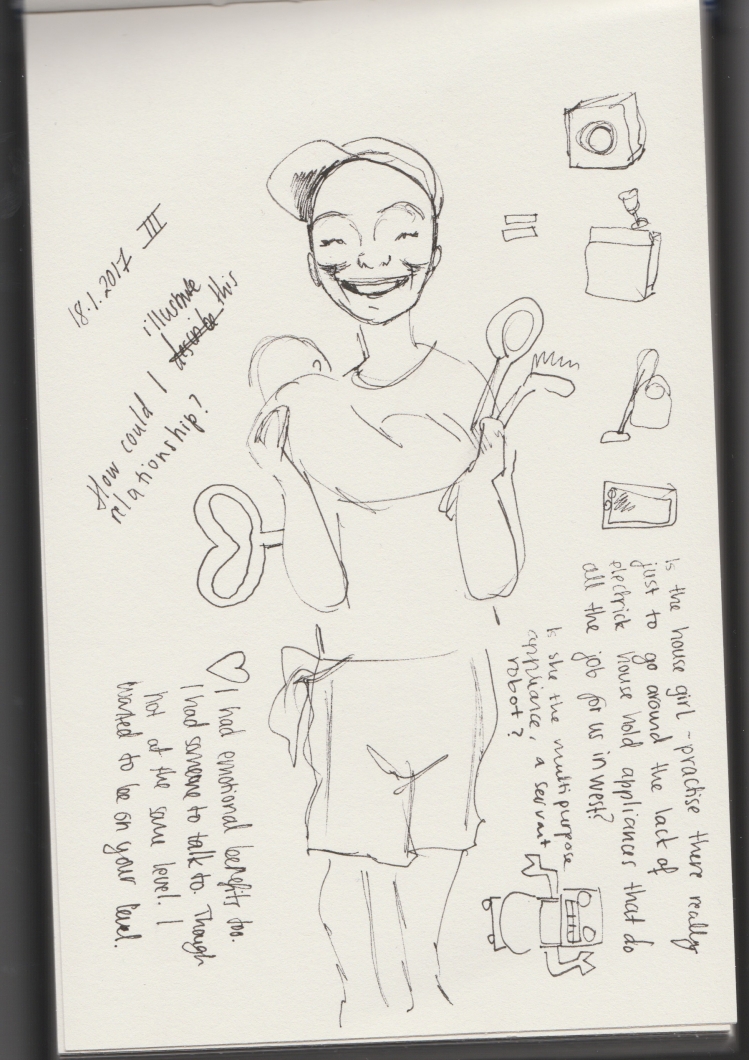I tried collage method and was amazed at the results. They lead me to a very personal topic which I think will be worth talking trough both text and images. I think I should concentrate now on the “house girl” child servitude practise that is common in Ghana and which I got involved. It is something that has bothered me but of which I have not been able to talk much about without trying to hide my true feelings and motifs. I think it would be great to use this study to open up this concept for others to understand and for myself too.
The servant role (linked to entertainer role) is often imposed to Africans. I could look at how the images of serving Africans have shaped my perceptions.

“To be honest I’m panicking now. I thought it would be easy to produce interesting illustrations but I’m still wondering around, floating in the sea of dull images. What is it that I really want to say? I don’t want to make pretty commercial images after all or diary like drawings of my life in Ghana. Well, the latter I do want, short of. I kind of want to bring up something personal. I also want to criticise. Could I criticise my own perceptions via illustrations?
This drawing is based on a different approach. I cut out images from magazines and tried to combine them to provoke some thoughts in me.
This combination of cake topper groom with a carved ceremonial mask / tourist mask decoration created an interesting character. He reminds me of coons, of slave waiters and the servitude and entertainment roles blacks are pushed to. It’s also about exoticism. It’s powerful in the way it talks about the role of africans as entertainers of tourists. As if the whole continent is a theatre set to amuse the white travellers who have come to see something amusing and exotic and primitive wrapped up in Western comfort. Another thought that came to mind is the noble savage concept.”

“Another take with the mask. This time the resulting image is a mammy character. A nurse servant. No much thoughts about this. Getting tired.
My baby was looked after by my in-law whose physical characteristics could well fit to the mammy role. But of course she was not a servant. She was our guest and she was honouring the tradition of helping (take care of) a new born baby.
We had also niece and nephew living with us. They were not considered “help” (as in domestic workers) but they did help us in exchange of upkeep and education. It was a benefit relationship though it was also a sentimental family relationship. It did borderline with having a servant and made me at times uneasy.
Maybe this relationship would be worth illustrating. It is a complex social issue and could be beneficial to bring it up. The phenomenon is known us “House Girl.”

“My dearest child, my lovely girl, how could I do this to you? To subject you to my work, to benefit from you once again? I already made use of our relationship by benefitting from your house help as you benefitted in terms of education and care. I should maybe seek your permission. Or would it make you uneasy? How could I even reach you now that you are in boarding school (without access to a mobile phone and internet)? Maybe the best solution would be to keep your identity a secret. Thought there is a change you will be recognised anyhow.
I kept telling myself you were like my child but it was not so. I was using you (in economical sense) We had a peculiar relationship, though in the Ghanian context it was normal.
I think this is really worth drawing and writing about. Servant roles and family ties mixed in this cultural habit.”
“How could I illustrate this relationship?
Is the house girl phenomenon there really just to go around the lack of electric house hold appliances that do all the job in the West? I s she the multipurpose appliance, a servant robot?
I had emotional benefits too. I had someone to talk to. Though not at the same level. I wanted to be on your level.”